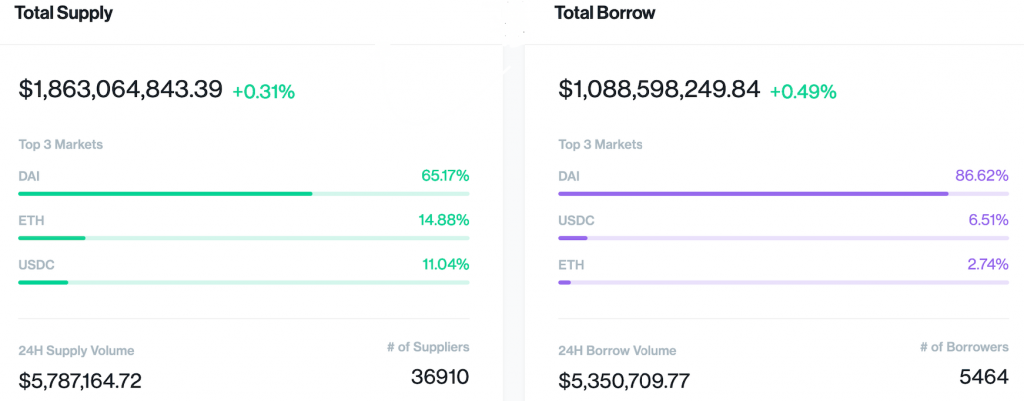What is DeFi?
DeFi or Decentralized Finance is a movement that aims at making a new financial system that is open to everyone and doesn’t require trusting intermediaries (like banks). To achieve that DeFi relies heavily on cryptography, blockchain, and smart contracts.
Smart contracts are the main building blocks of DeFi. If you don’t know what smart contracts are, you can check one of the previous articles where this is discussed.
DeFi Projects. What is trendy?
It is currently known that most if not all DeFi projects are built on Ethereum. The main reason for this is that Ethereum’s programing language called Solidity allows writing advanced smart contacts that contain the most necessary logic for the DeFi applications. It is worth commemorating that Ethereum has the most advanced ecosystem across all the smart contract developers, in fact, all the applications mentioned here are built on Ethereum.
In this article we are going to look at the different categories where DeFi is used:
Lending and borrowing
In this category, there is one main project that by this date is so far the biggest DeFi project – Compound.
It has around 1.8 billion dollars worth of assets locked in the protocol. Compound is an algorithmic and autonomous protocol that allows users to supply assets such as Ether, DAI, Basic Attention Token(BAT), 0x, Tether, and start making interest. It also has the option to borrow other assets.

MakerDAO is another project in the same category that allows users to use ETH to lend themselves money in the form of a stable coin called DAI and when users are ready to unlock their ETH, which serves as collateral for their DAI loan, they simply pay back the loan along with any fees. By combining loans with a stable currency, MakerDAO wants to allow anyone to borrow money and reliably predict how much they have to pay back.
Stable coins
With the help of smart contracts and certain incentives a stable coin can be created pegged to the US dollar without having to store money in the real world. As we mentioned MakerDAO that locks in collateral and generates DAI. DAi is a good example of an algorithmic stable coin. Except for DAI, there are other non-algorithmic stable coins such as Tether and USD coin. The problem with them is the fact that they are centralized because there is a company that stands behind them which is responsible for holding the equivalent of the stable coins in US dollars.

Decentralized Exchanges (DEXs)
DEXs enables the exchange of crypto assets in a completely decentralized and permissionless way, without giving up the custody of the coins. In other words, your coins or tokens do not need to be held by a third party exchange while you trade. Decentralized exchanges can also prevent price manipulation and are more anonymous than exchanges that implement know-your-customer requirements.
There are two main types of DEXs:
- Liquidity Pool based is the first one. Examples for this type are – UniSwap, Kyber network, and Bankor.
- Order Book based is the second type. Loopring, IDEX, and WeiDex are examples of an order booked based decentralized exchange.
Margin Trading
Margin trading similar to traditional finance is the practice of using borrowed funds to increase a position in certain assets. In contrast with regular trading in which traders use their own capital to fund trades, margin trading allows traders to multiply the amount of capital they are able to trade. This is why margin trading is also often referred to as leverage trading — “leverage” is the amount by which a trader is able to multiply their position. The main DeFi application in the margin trading space is Fulcrum.
Insurance
Insurance is another field of traditional finance that can be transformed into decentralized finance. Blockchain technology can contribute in many different ways enabling real-time data collection and analysis, which could make significantly speed up claims processing and payouts; ensuring that transactions are secure, authenticated, and verifiable, protecting customer’s privacy. It can provide certain kinds of guarantees of compensation in exchange for payment of premiums. One of the most popular applications are oriented with complications related to protection against smart contract failures and the protection of deposits. The most well-known insurance projects are Nexus Mutual and Opyn.
Conclusion
While more and more people are being drawn to these DeFi applications, it’s hard to say where they’ll go. Much of that depends on who finds them useful and why. Many believe various DeFi projects have the potential to become the next Robinhood, drawing in hordes of new users by making financial applications more inclusive and open to those who don’t traditionally have access to such platforms.
Stay tuned for our next article piece about the Blockchain world & Subscribe to our newsletter.



